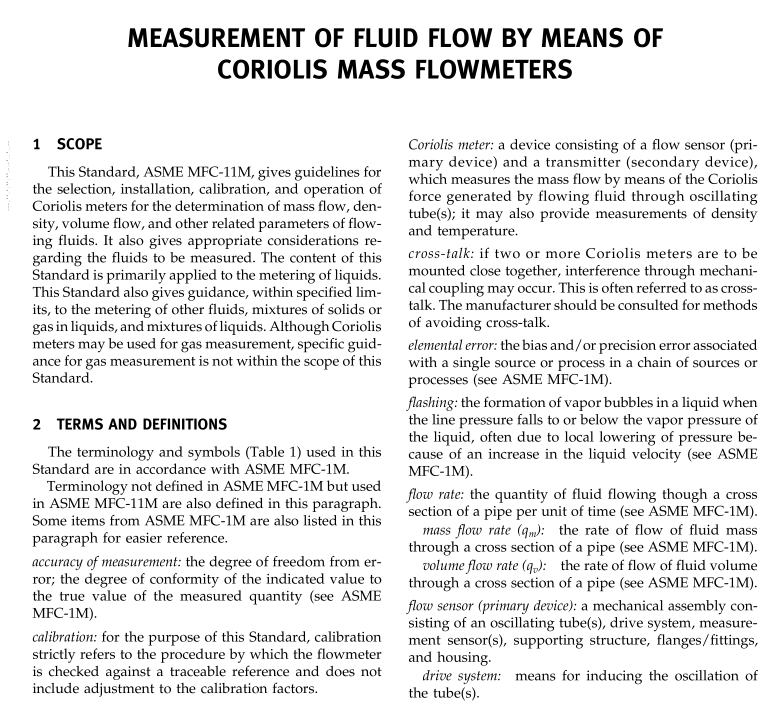ASME MFC-11M pdf download

ASME MFC-11M pdf download MEASUREMENT OF FLUID FLOW BY MEANS OF CORIOLIS MASS FLOWMETERS
3.3 Physical Installation
3.3.1 General. The manufacturer should describe thepreferred installation arrangement and state any restric-tions of use.See Appendix C. If needed, strainers, filters,air, and / or vapor eliminators or other protective devicesshould be placed upstream of the meter for the removalof solids or vapors that could cause damage or induceerrors in measurement. Coriolis meters are generallyplaced in the mainstream of the flow but can also beplaced in a by-pass arrangement for density measure-ments.
3.3.2 Installation Criteria. Consideration should begiven to the following points:
(a) the space required for the Coriolis meter installa-tion, including provision for external prover or master-meter connections, should in situ calibration be required(b) the class and type of pipe connections and materi-als, as well as the dimensions of theequipment to be used(c) the hazardous area classification
(d) the environmentaleffects on the sensor (e.g., tem-perature, humidity, corrosive atmospheres, mechanicalshock, vibration, and electromagnetic field)
(e) the mounting and support requirements
3.3.3 Full-Pipe Requirement.The meter performanceis impaired if the tubes are not completely filled withthe flowing fluid. The manufacturer may be consultedfor information on the meter’s performance and possiblemethods to purge or drain gases and/ or liquids fromthe sensor.
3.3.4Orientation. For proper operation, the flow sen-sor should be mounted such that the oscillating tube(s)remain completely filled with the process fluid whilethe fluid is being metered. Plugging, coating, trappedgas, or settling of solids can affect the meter’s perform-ance.The orientation of the primary device will dependon the application as well as the geometry of the oscillat-ing tube(s).
3.3.5 Flow Conditions and Straight Length Require-ments.The performance of substantially bent bending-mode Coriolis flowmeters are generally not affected byvelocity profile or fluid swirl.Straight piping lengthsadjacent to the meter are not typically required.Someslightly bent Coriolis meters may be affected by velocityprofile and swirl,so the Coriolis meter manufacturer’sinformation should be consulted for specific require-ments.
3.3.6 Valves. Valves upstream and downstream ofa Coriolis meter,installed for the purpose of isolation and zero adjustment,can be of any type, but shouldprovide tight shutoff. Control valves in series with aCoriolis meter should be installed downstream in orderto maintain a higher pressure in the meter and thusreduce the chance of cavitation or flashing.
3.3.7 Cleaning. For certain applications the Coriolismeter may require in situ cleaning, which, dependingon design, may be accomplished by
a) mechanical means (using a pig or ultrasonically)(b) self-draining
(c) hydrodynamic means:
(1) sterilization [steaming-in-place, (SIP)]
(2)chemical or biological [cleaning-in-place,(CIP)]NOTES:
(1) Care should be taken to avoid cross-contamination after clean-
ing fluids have been used.
(2) Chemical compatibility should be established between the sen-
sor wetted-materials,process fluid, and ceaning fluid.
3.3.8 Hydraulic and Mechanical Vibrations.The man-ufacturer shall provide the mechanical operating fre-quency of the instrument to enable assessment of possi-ble influence of process or other external mechanicallyimposed vibration frequencies. It is possible that theperformance of the meter may be influenced by vibra-tions at other than the operating tube frequency.Consul-tation with the manufacturer may be appropriate if vi-bration problems are anticipated or if they occur.
In environments with high mechanical vibrations orflow pulsation, consider the use of isolation or pulsationdamping devices (see para.3.4.7). It is advised to consultthe manufacturer for guidance in this case.
3.3.9 Flashing and/or Cavitation.The relatively highfluid velocities,which may occur in Coriolis meters,cause local dynamic pressure drops inside the meter,which may result in flashing and/ or cavitation. Bothflashing and cavitation in Coriolis meters (and immedi-ately upstream and/ or downstream of them) should beavoided. Flashing and cavitation may cause measure-ment errors and may damage the sensor.
3.3.10 Pipe Stress and Torsion. The flow sensor willbe subjected to axial, bending, and torsional forces dur-ing operation. Changes in these forces, resulting fromvariations in process temperature and / or pressure, canaffect the performance of the Coriolis meter, particularlyat flow rates low in the meter’s range.Under no circum-stances should the Coriolis meter be used to align and /or support the pipe work.









